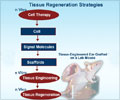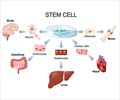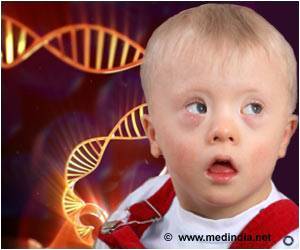Australian scientists have discovered how to identify probable stem cells from the womb’s lining.
Australian scientists have discovered how to identify probable stem cells from the womb’s lining. The finding, published in the journal Human Reproduction, opens up the possibility of using the stem cells for tissue engineering applications such as building up natural tissue to repair prolapsed pelvic floors.
Pelvic floor prolapse is a common condition, affecting over 50% of women after childbirth; around one in ten women have surgery and a third of these women require repeated operations to correct the problem. In research published online today (Thursday 13 September) in the journal Human Reproduction [1], Dr Caroline Gargett describes how she and her PhD student, Ms Kjiana Schwab, identified two markers, CD146 and PDGF-Rß, which they were able to use to isolate mesenchymal stem-like cells (MSC) from endometrial tissue using a high speed cell sorting machine (fluorescence activated cell sorting – FACS). Only 1.5% of the endometrial cells sorted in this way expressed both markers and, therefore could be MSC.They then investigated the properties of the MSC to discover whether they really were stem cells, capable of differentiating into a variety of different cell types. They found the cells were able to produce clones to form colonies of new cells at a rate that was 15 times greater than produced by the other endometrial cells. Furthermore, the MSC were able to differentiate into fat, bone, cartilage and smooth muscle cells in the culture dish. The MSC also appeared to be located around blood vessels in the endometrium (perivascular region). Dr Gargett, a senior scientist at the Centre for Women’s Health Research, Monash Institute of Medical Research, Monash University, Victoria, Australia, explained: “Colony-forming ability is a property of adult stem cells, as is the ability to differentiate into different cell types. The fact that the cells expressing the two markers were located in the perivascular region strengthens our case that we have isolated mesenchymal stem cells, because mesenchymal stem cells from bone marrow and fat are found around blood vessels too. It also gives us clues as to how they might function in repairing and regenerating new endometrium each month.”
This is the first time that researchers have been able to use markers to isolate MSC from the endometrium and also the first study to show that the properties of these cells mean they are highly likely to be stem cells. Dr Gargett said: “We had previously detected that MSC were present in the human endometrium but we were unable to isolate the MSC, which was a big drawback in studying their properties. The major finding of this study was the identification of two markers which enabled the prospective isolation of MSC-like cells from human endometrial tissue. This allows us to characterise endometrial MSC so we can understand their molecular and cellular properties better, compare them to MSC from other sources, such as bone marrow and fat, use them for tissue engineering applications, such as making constructs with biological scaffolds for pelvic floor prolapse surgery, and find where they are located in endometrium (i.e. around blood vessels); this gives us a clue as to how they might function in growing new endometrium each menstrual cycle and how they may have a role in gynaecological diseases such as endometriosis.”
The human endometrium is the only adult tissue that contains a substantial amount of the connective tissue framework (called stroma) that regularly regenerates under normal conditions when a woman menstruates. Because of its regenerative properties, Dr Gargett believed that it might contain MSC that were responsible for the monthly regeneration of the stroma and related blood vessels, and which could be an easily available source of MSC for stem cell therapy. However, until she identified CD146 and PDGF-Rß as MSC markers, there were no known markers and therefore no way of isolating the endometrial MSC. Her research, using tissue obtained from women aged between 31-49 who were having hysterectomies, indicates that the MSC are probably located mainly in the basalis layer of the endometrium, which is the layer that is not shed during a woman’s period. “We think that is where the MSC should be if they are responsible for producing the functionalis layer, which grows each month,” said Dr Gargett.
This means that, although it might be possible to collect MSC from menstrual blood, the most likely method of collection would be curettage or biopsy. “This would not be any more invasive than collecting MSC from bone marrow or surgical removal (biopsy) of fat tissue,” said Dr Gargett. “MSC could also be collected from postmenopausal women, whose endometrium is very thin. If these women are given oestrogen replacement therapy for a very short time (a week or two) their endometrium will grow to the thickness of a reproductive age woman and the MSC could be collected without harm to the woman.” Dr Gargett believes that initial applications for endometrial MSC would be to use them on the women that they had been retrieved from (rather than on other people) for gynaecological purposes such as pelvic floor prolapse. “Pelvic floor prolapse is a common problem that significantly impacts the lives of many women and they find it embarrassing to talk about – it is a hidden disorder in need of an innovative therapy,” she explained.
“Clinicians have been using a synthetic mesh as a reinforcement material to try and reduce the high rate of recurrence of this condition. While these meshes are often successful, a significant number of complications arise due to erosion or rejection of the foreign material. Increasingly clinicians have been trying biological scaffold material, but this often fails as it lacks cells and the body breaks it down faster than the body’s cells can infiltrate and strengthen the material. We believe that using a combination of biological scaffold and a woman’s own MSC might provide a solution that would ensure a longer lasting firm natural tissue that would be a superior support for the prolapsed uterus. “We also believe that the identification of the MSC in human endometrium gives us the opportunity to investigate their possible role in the development and pathogenesis of common gynaecological disorders associated with abnormal endometrial growth, such as endometriosis and adenomyosis.” [2] However, it will probably be at least ten years before applications from Dr Gargett’s findings will be used in the clinic. The next stages of the research include refining the technique by looking for further markers and possibly a single marker that could do the same job as two, and testing the possible tissue-engineering applications in animal models before they are used in humans.
Source-Eurekalert
ANN /J
 MEDINDIA
MEDINDIA
 Email
Email









